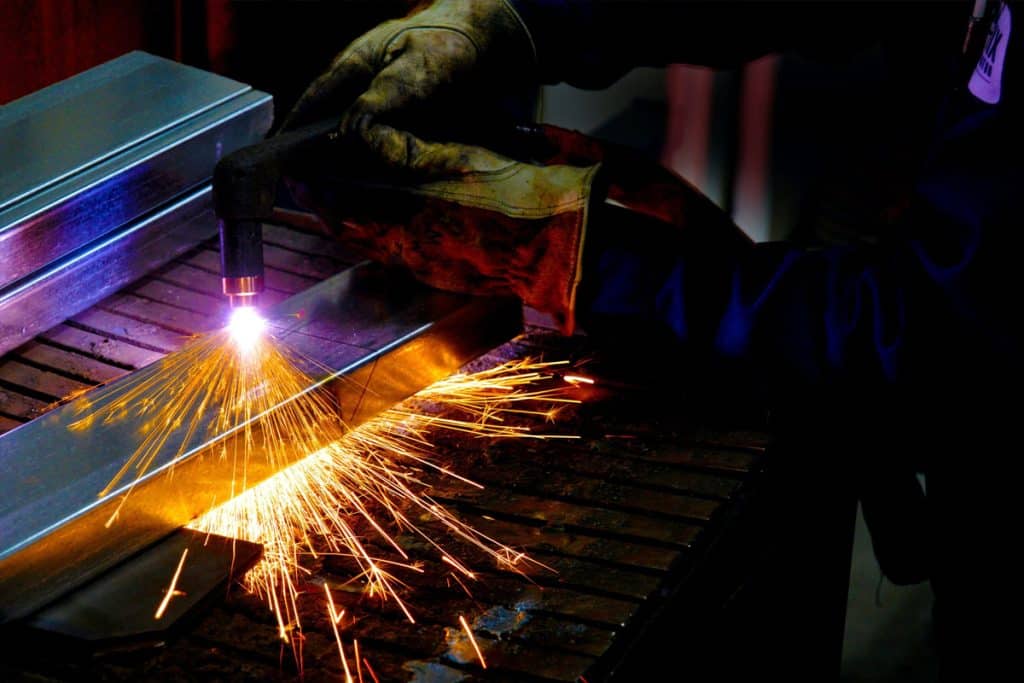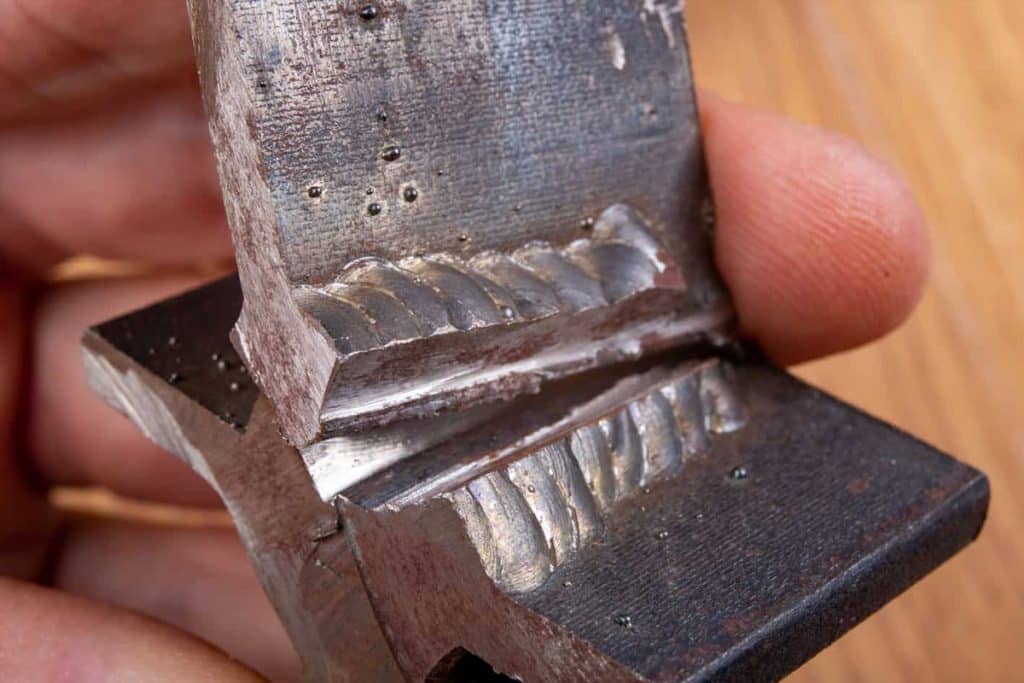Known for its corrosion resistance and wide range of uses in food handling, cutlery, and many other applications, stainless steel is one of the most popular metals in use today. The dozens of alloy variants make welding stainless steel more complicated than welding traditional carbon steel. However, while stainless alloys were once considered a major challenge to weld, today they are described as “different” as opposed to “difficult” among most welders.
Stainless Steels are high alloy steels containing a minimum of 10.5% chromium. Also, they are usually alloyed with other elements to improve heat resistance, mechanical properties, and fabricating characteristics. These alloying elements also modify and influence the weldability of stainless steel.
To successfully weld stainless, it is important to know the diverse types of stainless and their properties. They are divided into five main types: ferritic, martensitic, precipitation hardening, duplex, and austenitic.

Types of Stainless Steel
Austenitic
We carry: 301, 302, 303, 304, 316, 321, 347, N50 and N60
This class of stainless steel is highly corrosion-resistant, strong, and highly formable. But it is also prone to stress cracking. These are considered the most easily weldable stainless steel. There is no need for pre- or post-weld heat treatment.
Austenitic alloys are normally welded with fillers with a matching composition to the base material. There are a few exceptions though; 308 filler is used for alloys 302 and 304, and type 347 filler is used for 321.
Ferritic
We carry: 430
All ferritic alloys are in the 400 families, but not all 400s are ferritic. They have lower ductility, are more brittle, prone to hot cracking, and possess lower corrosion resistance than the austenitic grades. But they offer higher resistance to stress corrosion cracking. This type is generally considered to have poor weldability because at high temperatures it undergoes rapid grain growth. This leads to brittle, heat-affected zones.
If ferritic alloys are being welded, it is in sections less than 6mm thick. Any loss of toughness is negligible in a piece that thin. When welding the ferritic stainless, filler metals should be used that match or exceed the chromium level of the base alloy. 409 and 430 are commonly used as fillers and austenitic types 309 and 312 are for dissimilar joints.
Martensitic
We carry: 410, 420, 440
The 400 and 500 series make up the martensitic grades. These alloys have higher strength, wear resistance, and fatigue resistance than the austenitic and ferritic grades. But they are less corrosion-resistant. This grade becomes hard and brittle upon cooling, making it a great material for wear resistance but more difficult to weld as it tends to weld cracks on cooling.
However, martensitic stainless can be welded with careful precautions. The filler metals should generally match the chromium and carbon content of the base martensitic metal. Type 410 filler is used to weld types 402, 410, 414, and 420 steel. Austenitic types 308, 309, and 310 are also used to weld martensitic steels to themselves or dissimilar metals.
Precipitation-Hardening
We carry: 455, 13-8, 15-5, 17-4
Precipitation-hardening stainless steels contain both chromium and nickel. These metals provide a combination of the properties of martensitic and austenitic grades. They can be hardened through heat treatment to levels comparable to Martensitic steels while also being corrosion-resistant like austenitic steels.
P-H steels can be readily welded using procedures similar to those for 300-series stainless steels. Grade 17-4 is commonly welded with 17-7 filler and can be welded without preheating. As with many other alloys, achieving the same mechanical properties in the weld as in the parent material is difficult for P-H steels. Even when utilizing matching filler, it requires some careful preparation. Heat treatment after welding can be used to help the weld achieve close similarities to the parent metal.
Duplex
Duplex stainless steels are “duplex” because they possess a two-phase microstructure. This contains grains of both ferritic and austenitic stainless steel. These steels have significantly better toughness and ductility than ferritic grades. However, they do not reach the excellent values of austenitic grades. But they share a comparable corrosion resistance to the austenitic steels.
Modern duplex steels are readily weldable. But the procedure to maintain the heat input range must be strictly followed. Because of the material’s complex chemical composition, too much heat also adversely affects duplex stainless steel. Likewise, selecting a filler metal is slightly more challenging. Many types of duplex stainless base metals are not available as filler metals due to the fact that filler metal cools much more quickly than base metal.

Preparing To Weld
As in any type of welding, it is important to clean stainless steel before welding it. What you may not realize is how sensitive the stainless weld is to the presence of any carbon steel. Make sure any tools you use to clean your stainless are only used to clean stainless steel. For example, if you use a stainless steel brush to clean carbon steel, don’t use it again on any stainless steel. The same is true of stainless hammers and clamps.
Trace amounts of carbon steel can transfer to the stainless, causing it to rust. Similarly, grinding carbon steel in proximity to stainless steel can result in problems. Carbon steel dust suspended in the air can land on nearby stainless steel and lead to rusting. This is why it’s a good idea to keep carbon steel and stainless steel work areas separate.

Processes
The procedure for welding stainless steel isn’t vastly different from that of welding mild steel. Most stainless steel can be joined through several types of welding. In order to help you find the best one for your material, here’s a breakdown of the ratings for the weldability of stainless steel and other fabrication properties for each type of stainless steel.
Characteristics and Properties of Stainless Steels
| Item | Austentic | Ferritic | Martensitic | Precipitation Hardening | Duplex |
|---|---|---|---|---|---|
| Magnetic Response | Generally No | Yes | Yes | Yes | Yes |
| Weldability | Very High | Low | Low | High | High |
| High Temp Resistane | Generally No | High | Low | Low | Low |
| Low Temp Resistance | Very High | Low | Low | Low | Medium |
| Ductility | Very High | Medium | Low | Medium | Medium |
| Work Hardening Rate | Very High | Medium | Medium | Medium | Medium |
| Hardenable | By Cold Work | No | Quench & Temper | Age Harden | No |
| Corrosion Resistance | High | Medium | Medium | Medium | Very High |

Common Stainless Weld Defects
Understanding common defects when welding is the first step to preventing them. Welding stainless steel is not much different from that required in welding standard carbon steel, with a few exceptions. First, you must exercise more care and control with regard to heating and cooling stainless steel. Second, it’s important to properly match filler metals with the material being welded.
Cracking
The most common welding imperfection for stainless steel is cracking. Even austenitic stainless steels, the most readily welded of all stainless steels, have a risk of cracking. This is because austenitic steels lack ferrite, which dissolves harmful impurities that result in cracks. In order to prevent cracking in these metals, especially for fully austenitic structures, the choice of a filler containing ferrite is highly recommended.
Ferritic stainless steels, on the other hand, may crack during the welding process due to excessive grain coarsening which leads to poor toughness in the heat-affected zone. When welding thin sections, no special precautions are necessary. In thicker material or highly restrained joints, however, using a low heat input can minimize the size of the grain-coarsened zone and minimize the sensitivity to cracking. Likewise, using an austenitic filler may help to produce a tougher weld metal.
Martensitic steels are very prone to cold cracking as a result of hydrogen, which is also experienced with low-allow steels. The risk of cracking generally increases with the carbon content. The risk of cracking in martensitic stainless steels can be combated by utilizing a low hydrogen welding process such as TIG or MIG, or by using hydrogen-controlled fillers. Furthermore, pre- and post-weld treatments, especially for thicker sections and higher carbon materials, will help to toughen the structure, enable the hydrogen to diffuse from the weld metal and reduce the risk of cracking.
